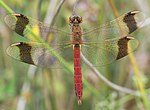Banded darter
| Banded darter | ||||||||||||
|---|---|---|---|---|---|---|---|---|---|---|---|---|

Banded darter ( Sympetrum pedemontanum ), male |
||||||||||||
| Systematics | ||||||||||||
|
||||||||||||
| Scientific name | ||||||||||||
| Sympetrum pedemontanum | ||||||||||||
| ( Allioni , 1766) |
The banded darter ( Sympetrum pedemontanum ) is a species from the family of the sail dragonflies (Libellulidae). It features eye-catching dark wing bands that are unmistakable. Its butterfly-like flight is also very striking and is somewhat reminiscent of the banded demoiselle ( Calopteryx splendens ). The species is considered a Siberian fauna element, which has its westernmost occurrence in central and southwestern Europe and is here in partly isolated litter finds. The type epithet pedemontanum (literally: "at the foot of the mountains") goes back to the place of discovery and first description, the Piémont .
features
It is a relatively small representative of the darter ( Sympetrum ) with a body length of around three centimeters and a wingspan of 4.5 to 5.5 centimeters. Both sexes have a drawing of dark brown ribbons that run across all four wings at about the same level as the wing markings (slightly offset inwards). Young males as well as females have a yellow-brown abdomen and whitish (yellow-brown in old females) wing marks. In the mature male the abdomen is red, as are the wing marks; the thorax is brown. The legs are colored completely black.
distribution
The area of the species extends from Central Europe to East Asia; a distinction is made between the European-West Siberian nominate form , the East Siberian subspecies Sympetrum pedemontanum kurentzovi and the subspecies S. p. elatum distinguished. The western part of the distribution area consists of a narrow band between the 45th and 50th parallel as well as further, partly disjoint relict populations or outposts in Central Europe (westwards to Belgium and eastern France, island-like but also in central Spain). Within Germany, the banded darter was observed almost only in southern Bavaria and southwestern Baden-Württemberg until the 1970s. Since then, however, finds have been increasing in parts of northern and eastern Germany, with rivers such as the Elbe or the Aller representing important lines of expansion to the northwest. While the species has spread in the north (east) German lowlands in recent decades, this was apparently not the case in southern Germany.
Habitat and way of life
The banded darter mainly inhabits heat-favored river valleys with rather shallow, moderately silted, submerged partly weed, sunny and wind-protected waters, such as drainage ditches, ponds in gravel pits, boggy ponds, oxbow lakes and floodplains. Transformed animals appear from midsummer (north of the Alps around mid to late July, exceptionally as early as the end of June); their flight time extends until around the beginning of October. They are often associated with other Sympetrum species, in particular with the large , common , spotted and blood-red darter .
The wing drawing provides an optical effect in the sense of a flicker and a dissolution of the contours in flight. The low-flying animals are therefore difficult to see, and the often resting individuals are surprisingly well camouflaged in the vegetation. Banded darter are not very aggressive towards each other or towards other dragonfly species, but are themselves often attacked by other dragonflies. Their lifespan as a metamorphosed full insect is a maximum of about four weeks.
Adults
The maiden flight of the often collectively hatching on shore waters imagines usually ends after a few meters in the vegetation around. After they have hardened, they go to mature and hunting habitats, for example meadows, tall herbaceous vegetation and swamps. The sexually mature dragonflies soon return to the water. The males probably occupy territories, but do not defend them particularly "spirited" against competitors. The copulation is preceded by the formation of dragonflies typical "tandem" of males and females, as is usually the case with the subsequent laying eggs above the water. The oviposition is repeatedly interrupted by breaks and new copulations.
Larvae
After the eggs have hibernated, which also survive phases of drying, the larvae hatch in the following spring to early summer. Their further development takes only about five to eight weeks, during which they go through eleven larval stages. Nothing is known about their way of life; the exuvia , unlike those of other darter, are mostly encrusted with mud.
Hazard and protection
The banded darter is a “specially protected” species according to the German Federal Nature Conservation Act and the Federal Species Protection Ordinance. It is classified as “endangered” in Germany's Red List , in Austria also (“vulnerable”), in Switzerland it is threatened with extinction ("Critically endangered"). The species is considered a relatively weak and pioneer dragonfly. Intensive care and maintenance measures on and around ditches can have a significant impact on their populations, such as annual weed removal over long distances and the radical mowing of herbaceous perennials on ditch embankments. On the other hand, over time, too much silting up waters lose their attractiveness for this species.
swell
literature
- H. Bellmann: The Kosmos dragonfly guide. Franckh-Kosmos Verlags GmbH & Co., Stuttgart 2007, ISBN 978-3-440-10616-7 .
- H. Hunger, F.-J. Schiel, W. Röske & K. Sternberg: Sympetrum pedemontanum (Allioni, 1766) - Banded darter. In: Sternberg, K. & R. Buchwald (eds.): Die Libellen Baden-Württemberg. Volume 2: Dragonflies (Anisoptera). Ulmer, Stuttgart 2000, ISBN 3-8001-3514-0 , pp. 578-587.
Individual evidence
- ↑ Red list of dragonflies in Germany at www.libelleninfo.de
- ^ Red list of dragonflies in Austria at www.libelleninfo.de
- ↑ Red list of dragonflies in Switzerland at www.libelleninfo.de





